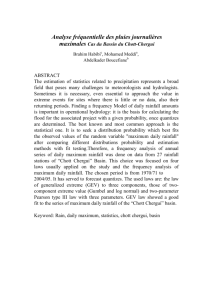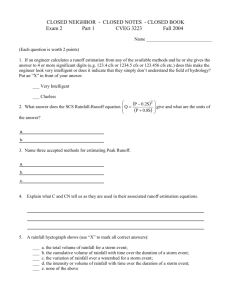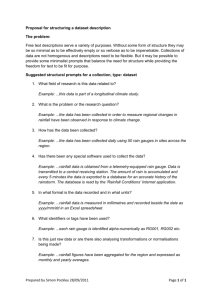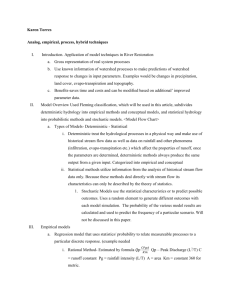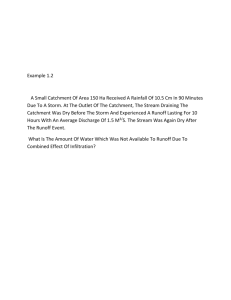A joint model for rainfall-runoff: The case of Rio Grande Basin
advertisement
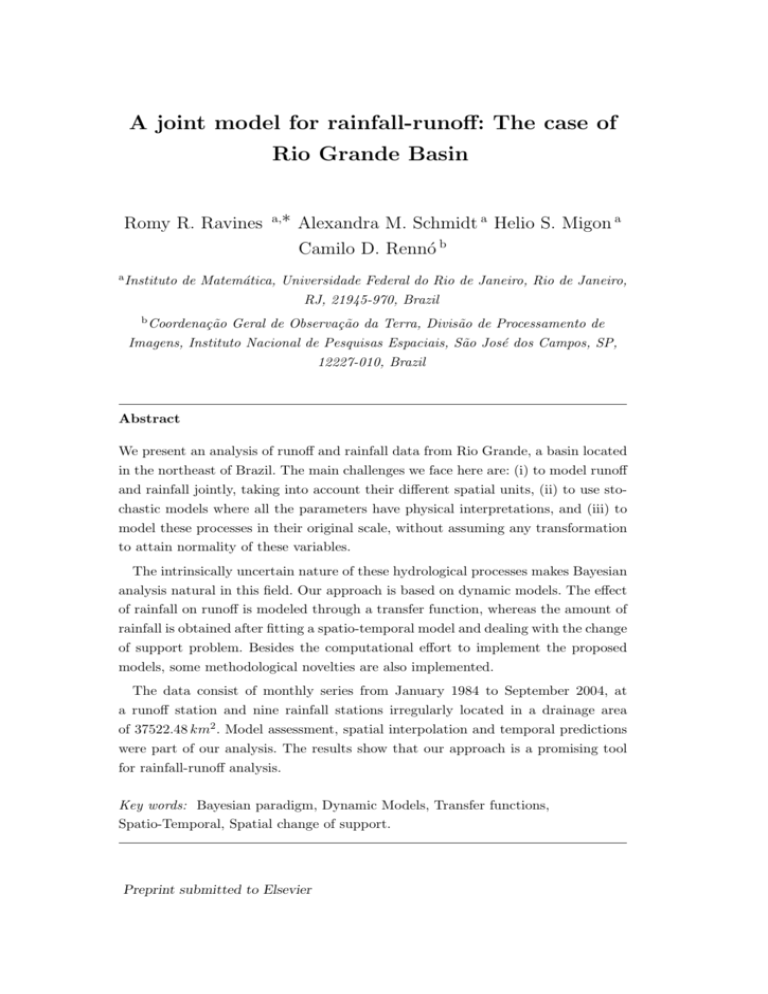
A joint model for rainfall-runoff: The case of
Rio Grande Basin
Romy R. Ravines
a,∗
Alexandra M. Schmidt a Helio S. Migon a
Camilo D. Rennó b
a Instituto
de Matemática, Universidade Federal do Rio de Janeiro, Rio de Janeiro,
RJ, 21945-970, Brazil
b Coordenação
Geral de Observação da Terra, Divisão de Processamento de
Imagens, Instituto Nacional de Pesquisas Espaciais, São José dos Campos, SP,
12227-010, Brazil
Abstract
We present an analysis of runoff and rainfall data from Rio Grande, a basin located
in the northeast of Brazil. The main challenges we face here are: (i) to model runoff
and rainfall jointly, taking into account their different spatial units, (ii) to use stochastic models where all the parameters have physical interpretations, and (iii) to
model these processes in their original scale, without assuming any transformation
to attain normality of these variables.
The intrinsically uncertain nature of these hydrological processes makes Bayesian
analysis natural in this field. Our approach is based on dynamic models. The effect
of rainfall on runoff is modeled through a transfer function, whereas the amount of
rainfall is obtained after fitting a spatio-temporal model and dealing with the change
of support problem. Besides the computational effort to implement the proposed
models, some methodological novelties are also implemented.
The data consist of monthly series from January 1984 to September 2004, at
a runoff station and nine rainfall stations irregularly located in a drainage area
of 37522.48 km2 . Model assessment, spatial interpolation and temporal predictions
were part of our analysis. The results show that our approach is a promising tool
for rainfall-runoff analysis.
Key words: Bayesian paradigm, Dynamic Models, Transfer functions,
Spatio-Temporal, Spatial change of support.
Preprint submitted to Elsevier
1
Introduction
One of the challenges that hydrologists and operators of water resource systems
face is to predict the runoff given the rainfall. The intrinsically uncertain nature of
these hydrological processes makes Bayesian analysis natural in this field, whenever
statistical problems are considered (Rios-Insua et al., 2002).
In this paper we present an alternative strategy for dealing with the spatial and
temporal features of two of the most important hydrological variables: runoff and
rainfall. Our goals are: (i) to model both variables jointly, taking into account their
different spatial units, (ii) to use stochastic models where all the parameters have
physical interpretations, and (iii) to model these processes in their original scale,
without assuming any transformation to attain normality of these variables.
Several types of stochastic models have been proposed for the rainfall-runoff relationship, based on deterministic models or on classical time series analysis. Two
important classes of stochastic models applied to river flow analysis are: transfer
function and regime switching. Transfer function modeling is flexible and has been
mainly used in the form of ARMAX models (see, for example, Sales (1989) and
Capkun et al. (2001)). Markov Switching time series models, as in Lu & Berliner
(1999) have been recently introduced. These approaches are not ideal, because data
transformation is needed and the parameters do not have interpretation in physical
terms. Also, in all the previous proposed models, the measurement errors and uncertainty associated with rainfall are not explicitly accounted for. This is because
models must describe the rainfall-runoff process on a drainage catchment area basis. However, in practice, precipitation is measured at more than one monitoring
station within a basin, thus some procedure is needed in order to approximate the
precipitation for the whole basin. There are some widely used methods that make
use of polygons to determine the influence area of each station. The total basin’s
precipitation is computed as a weighted mean of the precipitation measured at each
station. The problem with this kind of procedure is that the uncertainty of this
estimation is not taken into account when modeling runoff as a function of rainfall.
∗ Corresponding author.
Email addresses: romy@dme.ufrj.br (Romy R. Ravines ), alex@im.ufrj.br
(Alexandra M. Schmidt), migon@im.ufrj.br (Helio S. Migon), camilo@dpi.inpe.br
(Camilo D. Rennó).
2
Here we propose a joint model for both variables: rainfall and runoff. For rainfall,
we use spatio-temporal models, like in Sansó & Guenni (2000). For runoff, we use
non-normal and non-linear Bayesian dynamic models. In particular, we extend the
models presented by Migon & Monteiro (1997). Additionally, to approximate the
basin’s rainfall, we solve the implicit change of support problem (see Cressie (1993)
and Gelfand et al. (2001) for further details). The models presented here allow us
to represent parsimoniously a complex system of physical processes, which fit and
forecast rather well, without losing the physical interpretation of their parameters.
Inference procedure is performed under the Bayesian paradigm. Markov Chain Monte
Carlo (MCMC) methods are used to assess posterior distributions of the unknown
quantities. Since the proposed models can be computationally intensive when fitted
with MCMC techniques, we sought to use algorithms that perform thousands of
iterations in a few minutes. In particular we focused in the runoff model, for which
we used a sampling scheme recently proposed by Ravines et al. (2007). It combines
the conjugate updating of West et al. (1985) for dynamic models in the exponential
family, with the backward sampling of Frühwirth-Schnater (1994).
This paper is organized as follows. In Section 2 we briefly describe the Brazilian data
we used to illustrate our methodology. Section 3 is devoted to a general discussion
of some particular individual models for runoff and rainfall previously proposed. In
Section 4 the joint model proposed here is described and the main aspects of the
inference procedure are discussed. In Section 5 we present the results of the analysis
of the Rio Grande basin data, and in Section 6 we offer some concluding remarks.
2
Rio Grande Basin, Brazil: Runoff-Rainfall Data
The Rio Grande basin is located in the northeast of Brazil, in Bahia State, a dry
sub-humid area with tropical weather. The region under study is between the 11o
and 13o South parallels and 43o 300 and 46o 300 West meridians. This basin has a
drainage area of 37522.48 km2 . The available dataset consists of monthly recorded
series from August 1984 to September 2004 (242 months), at one runoff station
(Taguá), and nine rainfall stations irregularly located in the drainage area. Figure
1(a) shows the location of each station and Figure 1(b) shows the data for the four
monitoring stations marked in 1(a).
From Figure 1(b) we observe that there are distinct wet and dry periods annually:
3
400
0
200
1
500
2
200
Tagua
2
1
0
Runoff
3
400
Legend
0
800
3
Rainfall
Taguá
0
62.5
Kilometers
125
300
Rivers
Selected Grid
250
100
Total Grid
1985
(a) Locations of the monitoring stations
1990
1995
2000
2005
(b) Some observed time series
Figure 1. Rio Grande Basin: (a) Locations of the monitoring stations; (b) Time series of
monthly runoff at Taguá, and rainfall at sites 1, 2, and 3 (marked in (a)).
the rainy season begins in November and lasts through March, with the average
accumulated monthly rainfall over 275mm; while the dry season is from late April
until October, when the average monthly rainfall rarely exceeds 10mm. Most of the
basin is sparsely vegetated and relatively flat, meaning that altitude has no influence
in the hydrological regime. Thus, it is not taken into account in our models.
3
Individual models for rainfall and runoff
Two of the main features of the rainfall-runoff relationship are: it is basically nonlinear and the current runoff depends on previous runoff plus current and past
precipitation. It can be assumed that there is no feedback between runoff and rainfall,
so a transfer function model seems to be a natural option for fitting and forecasting
this phenomenon. Besides, runoff is a non-negative variable and its time series can
be non-stationary. Thus, we propose the use of non-linear and non-normal dynamic
models to handle this kind of data.
Let Yt be the runoff and Xt be the precipitation at time t. The rainfall-runoff rela4
tionship can be represented by
Yt ∼ p(Yt |µt , φt ),
t = 1, 2, . . .
g(µt ) = f1 (αt , Et )
Et = f2 (Et−1 , . . . , E0 , Xt ),
(1a)
(1b)
(1c)
where p(Yt |µt , φt ) is a density function for a non-negative random variable; µt is
the expected value of Yt ; φt represents other parameters of p(Yt |µt , φt ); αt is a basic
level and Et is the total effect of rainfall at time t; and g(·), f1 (·) and f2 (·) are
known functions describing the dynamics of the hydrological process. Time varying
parameters and stochastic variations affecting Et are particular cases of (1).
3.1
A dynamic transfer function model
Following the assumptions made in Migon & Monteiro (1997), the relationship between runoff and rainfall can be expressed as a transfer function model. The model
in (1) assumes that the expected value of the total runoff generated (streamflow),
µt , or a function of it, say g(µt ), can be written as a baseflow αt , which depends on
the water table level, plus an effect of current and past precipitation Et , which is
µt = αt + Et . The effect of precipitation is expected to decay between time t − 1 and
t by a rate ρt ∈ (0, 1). This parameter plays the role of a recharge or rainfall effect
memory rate and depends on the geomorphology and land-use/land-cover of the
basin. Therefore, it should be (almost) constant over time. Temporal changes in this
parameter can be explained by drastic changes in, e.g., soil and/or vegetation characteristics. Since Et−1 represents the effect of precipitation before time t, a fraction of
current rainfall, say γt Xt , can be added to compute the rainfall effect at time t. The
parameter γt measures the instantaneous effect of rainfall and is mainly associated
with overland flow speed. This parameter has a particular temporal dynamic: it is
strongly related to the soil infiltration capacity and the rainfall interception by the
vegetation. After a rainy period, the soil is saturated and the overland flow will be
high. However, after a dry period, the soil absorbs a great part of water and the overland flow will decrease. Also, when vegetation grows, the leaf density becomes high,
increasing the rainfall interception and consequently decreasing its instantaneous
effect on the discharge. Alternatively, if ϑt is the maximum expected precipitation
effect, then ϑt > µt and the remaining possible runoff is ϑt − (αt + ρEt−1 ). Therefore
5
Et , in (1c), can be expressed as one of the following expressions:
Et = ρt Et−1 + γt Xt
(2a)
Et = ρt Et−1 + [1 − exp(−κt Xt )][ϑt − (αt + ρt Et−1 )].
(2b)
0.30
Equations (2a) and (2b) support the hypothesis that the precipitation effect decays
exponentially with time. In equation (2a), the greater the amount of rainfall, the
greater is its returns to runoff. This hypothesis is known as proportional returns.
On the other hand, in equation (2b), the greater the amount of rainfall, the smaller
is its effect and, moreover, this effect has an upper limit. The latter is known as the
diminishing returns hypothesis. Figure 2 illustrates these functions for some fixed
values of their parameters.
●
●
●
15
3
0.20
5
●
●
●
●
●
●
2
●
5
1
●
●
●
●
●
●
15
●
●
●
●
20
●
●
●
●
0
●
10
●
●
●
●
●
●
●
0
●
●
●
Et
10
Et
Et
0.10
●
●
●
●
●
●
●
●
●
●
●
●
●
●
●
●
●
●
●
●
●
●
●
●
0.00
4
●
●
●
5
10
20
Xt
Time
(a) Exponential decay
15
(b) Proportional returns
●
5
10
15
20
Xt
(c) Diminishing returns
Figure 2. Examples of the shapes of the transfer functions in (2a) and (2b).
3.2
Modeling rainfall
Note that the input Xt in model (1) corresponds to the precipitation of a whole
basin, that is, a unique measure of rainfall is needed at each time t. However, in
many situations, precipitation is observed in more than one station within a basin.
So, the total rainfall for time t, Xt , should be obtained from the solution of the
spatial change of support problem. The change of support problem is concerned
with inference about the values of the variable over areal units (block data) different
from those at which it has been observed (Gelfand et al., 2001). Areal rainfall can
be viewed as a sum over point rainfall data, because it is a continuous univariate
spatial process.
Let {Xt (s), s ∈ B ⊂ R2 , t = 1, 2, . . .} be a spatial random field at discrete time t.
Here, Xt (s) ≥ 0 is a random variable that represents the amount of rainfall at time
t and location s. So, the rainfall for a given basin or region B, Xt , is given by
Xt =
Z
B
Xt (s)ds,
6
(3)
where B is the basin’s domain. In particular, we assume Xt (s) follows a truncated
normal distribution and, as suggested by Sansó & Guenni (2000), is represented by
the following spatio-temporal model:
Xt (s) =
wt (s)β
if wt (s) > 0,
0
if wt (s) ≤ 0
s ∈ B,
(4a)
wt = Z t + ν t
ν t ∼ GP (0, τ 2 I),
(4b)
Z t = F 0 θ t + t
t ∼ GP (0, σ 2 V ),
(4c)
θ t = Gθ t−1 + ω t
ω t ∼ GP (0, W t ),
(4d)
where GP denotes a Gaussian ‘process and τ 2 I and σ 2 V are the covariance matrices
of wt and Z t , respectively. Here I denotes the identity matrix. The term ν t is a
random error whose variance, τ 2 , is known as the nugget effect (Cressie, 1993). The
variance of each Zt (.) is denoted by σ 2 , and its correlation function is represented by
%(ksi − sj k, λ) = Vij , which depends on λ, and on the Euclidean distance, || si − sj ||,
between the locations si and sj . In this case, F 0 θ t represents a polynomial trend
and G is the evolution matrix of the parameters θ t . An alternative way of modeling
rainfall is to use a model derived from a mixture taking into account the excess of
zeros (dry season), as in Velarde et al. (2004) and Fernandes et al. (2007) .
Fitting Equations (1) and (3) jointly is our proposed approach. Our formulation
covers a wide class of relationships. It is very flexible and all of its parameters have
a clear interpretation. Moreover, all the uncertainty involved in the physical process
is clearly taken into account, as rainfall is not considered as a known quantity.
4
A simultaneous model for rainfall-runoff
Assume that we have runoff data from T time periods and rainfall data from S
locations over a basin B, observed during the same time period. Let Yt and Xt be
the basin’s runoff and rainfall at time t, respectively. Then, Y denotes the basin’s
runoff time series, that is, Y = (Y1 , . . . , YT )0 , and X denotes the basin’s rainfall time
series, that is, X = (X1 , . . . , XT )0 . Let Xt (si ) denotes rainfall at time t and gauged
location si . Then, X t (s) = (Xt (s1 ), . . . , Xt (sS ))0 is the rainfall observed at time t
over the S gauged locations (for each time t ), and X(si ) = (X1 (si ), . . . , XT (si ))0 is
the rainfall time series observed at gauged site si (for each location). And, X(s) =
(X(s1 ), . . . , X(sS ))0 , with s denoting the vector of gauged locations (s1 , . . . , sS ), is
7
the matrix of rainfall observed at the S locations over T time periods. The joint
distribution (see Appendix A for details) of Y , X and X(s) is given by
p(Y , X, X(s)|Θ) = p(Y |X, X(s), ΘY )p(X, X(s)|ΘX ),
(5)
where Θ = (ΘY , ΘX ), ΘY denotes the parameters in (1) and ΘX denotes the
parameters in (4). Note that in (5) the joint distribution of runoff and rainfall
is modeled through the conditional distribution of runoff given rainfall, times the
marginal distribution of rainfall (Schmidt & Gelfand, 2003). Also,
p(Y , X, X(s)|Θ) =
T
Y
p(Yt |Xt , X t (s), ΘY )p(Xt , X t (s)|ΘX )
t=1
=
T
Y
p(Yt |Xt , X t (s), ΘY )p(Xt |X t (s), ΘX )
t=1
S
Y
p(Xt (si )|ΘX ).
(6)
i=1
Gelfand et al. (2001) proposed to approximate p(Xt , X t (s)|ΘX ) by using Monte
Carlo integration. They proposed to sample a set of observations in SB locations,
independent and uniformly distributed over B, and compute
X̂t =
SB
X
X̂t (si ) i = 1, . . . , SB ,
(7)
i=1
where X̂t (si ) is the predicted value for rainfall at the i−th location from a regular
interpolation grid (with locations s∗1 , s∗2 , · · · , s∗SB ) of SB points constructed inside the
bounds of B. Consequently, (7) is a Monte Carlo approximation of (3).
The predictive distribution needed for the spatial interpolation of Xt (si ), at a new
set of locations, for instance, (Xt (s∗1 ), . . . , Xt (s∗SB ))0 , is given by
0
p(X(s )|X(s)) =
Z
p(X(s0 )|X(s), ΘX )p(ΘX |X(s))p(ΘX )dΘX ,
(8)
where ΘX denotes all the parameters in (4).
Following the Bayesian paradigm, model specification is complete after assigning
the prior distribution of all the unknowns. From Bayes’ theorem we obtain the
kernel of the posterior distribution, which does not have an analytical closed form.
Samples from the posterior distribution can be obtained via Markov chain Monte
Carlo (MCMC) methods (Gamerman & Lopes, 2006). Based on the expressions
above, the inference procedure via MCMC can be done in the following steps:
8
(1). Fit a spatio-temporal model for rainfall, X(s), observed at S gauged locations
over B;
(2). Build a regular grid over the domain and obtain a sample of the rainfall over
the basin, X, following equations (7) and (8). That is, first obtain a sample
from the predictive distribution of X(s) (for each point of the interpolation
grid), then use these values to approximate the rainfall over the basin using
equation (7);
(3). For each sampled value of rainfall over the basin, Xt , obtained in the previous
step, fit the runoff model as in equation (1).
In particular, we assume that runoff follows either a lognormal or a gamma distribution. In the case of the lognormal distribution, we applied a log transformation and
the algorithm forward filtering backward sampling (FFBS) of Frühwirth-Schnater
(1994) was used to obtain samples of the posterior distribution of interest. In the
case of the gamma distribution, we propose the use of a sampling scheme which
combines the conjugate updating of West et al. (1985) for dynamic models in the
exponential family, with the backward sampling of Frühwirth-Schnater (1994). This
algorithm is called conjugate updating backward sampling (CUBS); details are found
in Ravines et al. (2007). We note that in non-normal transfer function models CUBS
significantly reduces the computing time needed to attain convergence of the chains,
and is also very simple to implement.
5
Modeling in practice: Inference procedure
We applied the approach described in Section 3 to the rainfall data from the nine
stations and the runoff series observed at Taguá station in the Rio Grande basin.
Specifically, we used the function in (2a) for Et in (1c) and a multivariate dynamic
linear model (see West & Harrison (1997, Chapter 16)) for the temporal evolution
of the parameters in (4). For a better explanation, we reproduce our whole, general,
9
model in (9).
Yt |Xt ∼ p(µt , φ)
t = 1, . . . , T
log(µt ) = αt + Et
(9a)
(9b)
wt ∼ N (0, σE2 )
(9c)
αt = Gα αt−1 + wα,t
wα,t ∼ N (0, σα2 )
(9d)
γt = Gγ γt−1 + wγ,t
N (0, σγ2 )
(9e)
j = 1, . . . , SB
(9f)
i = 1, . . . , S
(9g)
Et = ρEt−1 + γt Xt + wt
Xt =
SB
X
wγ,t ∼
X̂t (sj )
j=1
Xt (si ) =
wt (si )β
se wt (si ) > 0
0
se wt (si ) ≤ 0
wt = z t + ν t
ν t ∼ NS (0, τ 2 I)
(9h)
z t = F 0 θ t + t
t ∼ NS (0, σ 2 V t )
(9i)
θ t = Gθ t−1 + εt
εt ∼ Nk (0, W t )
(9j)
θ 0 ∼ N (0, 100I),
(9k)
where p(µt , φ) is the log-normal or gamma distribution and φ corresponds to the
precision parameter of the former and the shape parameter of the latter. In (9g)–
(9k), S is the number of monitoring sites and SB is the number of points in the
interpolation grid. Xt (si ) denotes the rainfall at time t = 1, . . . , T and site si =
s1 , . . . , sS , wt (si ) is a latent Gaussian variable, β is an unknown power, wt is a vector
of dimension S that stacks the S observations made at time t, τ 2 is a nugget effect,
σ 2 > 0 and V t is a spatial correlation matrix of dimension S. Here we assume that
Vsi ,si0 = exp(−λdsi ,si0 ), that is, an exponential decay correlation where λ controls
the decay rate, λ > 0 and dsi ,si0 is the Euclidean distance between sites si and si0 ,
i, i0 = 1, . . . , S. In (9i)–(9k), F 0 is an S × k matrix, G is a k × k matrix and θ is a
vector of dimension k. The elements of θ are such that θ t = (θ t1 , θ t2 )0 , where θ t1 is
a sub-vector that describes the spatial trend and θ t2 describes the seasonal effects.
Equations (9d) and (9e) represent possible time evolutions of α and γ, respectively.
In practice, just one of these equations is considered and depends on the features of
the basin under study.
10
5.1
Prior distributions and full conditional distributions
In general, we used fairly vague prior distributions. However, since all the involved
parameters have physical interpretations, an elicitation procedure could be done. For
the parameters of the spatio-temporal model in (9g)-(9k), we set p(θ 0 , σ 2 , ς 2 , λ, β) =
p(θ 0 )p(σ 2 )p(ς 2 )p(λ)p(β), where ς 2 = τ 2 /σ 2 , p(θ 0 ) is an S−variate normal distribution with mean 0 and an identity covariance matrix, NS (0, I) and p(σ 2 ) is an
improper distribution, 1/σ 2 . On the other hand, p(ς 2 ), p(λ) and p(β) are gamma
densities with parameters (0.001, 0.001), (2.00, 6/1.86) and (12, 4), respectively. The
hyper-parameters for λ were selected according to the premise that at half of the
maximum distance between the observed points, the spatial correlation is almost
zero. The hyper-parameters for the prior of β were chosen such that its expected
value was 3, representing the cubic root transformation recommended in the hydrological literature (Sansó & Guenni, 2000).
Following Bayes’ Theorem, the posterior distribution is proportional to the likelihood
times the prior distribution. For the spatio-temporal model in (9g)-(9k), the posterior
distribution is given by
1 ST 1 ST /2
|V (λ)|−T /2
σ2
ς2
T
1 X
1
exp − 2
kwt − z t k2 + (z t − F 0 θ t )0 V (λ)−1 (z t − F 0 θ t )
2σ
ς2
p(σ 2 , ς 2 , λ, β, z, θ|X) ∝
t=1
−
T
1X
2
t=1
Y x1/β−1 it
(θ t − Gθ t−1 )0 W −1
(θ
−
Gθ
)
p(θ 0 , σ 2 , ς 2 , λ, β). (10)
t
t−1
t
β
xit >0
From (10), we have the following full conditional distributions (f.c.d.): σ 2 and ς 2
are inverse gamma, z is multivariate normal, and wij < 0 is a univariate truncated
normal. The f.c.d. of λ and β do not have a known closed form. Since θ t are the
state parameters of a normal dynamic model, their f.c.d. are multivariate normals.
For the dynamic models in (9a)-(9c) we also set independent priors to all the parameters. In particular, we considered normal prior distributions with zero mean and
variance 103 for E0 , α and γ and a uniform distribution over [0, 1] for ρ. For all the
2
variance terms, (σY2 , σE2 , σW
), we assigned inverse gamma distributions with both
hyper-parameters equal to 0.01. When the gamma distribution is used to model
the runoff, a gamma distribution with both parameters equal to 0.01 was used as a
prior for φ, the shape parameter in (9a). In this case, the f.c.d. of the unknowns in
(9a)-(9c) depend on the distribution assumed for Yt and the hypothesis for σE2 , σα2
11
and σγ2 . In particular, if p(µt , φ) is a gamma distribution and σα2 = σγ2 = 0, the f.c.d.
of γ and σE2 are normal and inverse gamma, respectively, and the f.c.d. of α, ρ and
φ do not have a known closed form.
5.2
Some computational details
In order to sample from the posterior distribution, we used a hybrid Gibbs sampling algorithm (Gelfand & Smith, 1990). Samples from the f.c.d. of λ, β, α and ρ
were obtained through the slice sampling algorithm (Neal, 2003). We made use of
a Metropolis-Hastings step to sample φ. Samples from θ t were obtained with the
forward filtering backward sampling (FFBS) procedure (Frühwirth-Schnater, 1994).
Following Sansó & Guenni (2000), we used discount factors for W t : δT = 0.90 for
the spatial trend and δS = 0.95 for the seasonal effects. Finally for σα2 and σγ2 we
used a discount factor of 0.95, whenever these parameters were considered in the
model.
The MCMC algorithm for the spatio-temporal model was iterated 70 000 times after
a burn-in of 10 000 steps, for two parallel chains. We stored every 10th iteration.
For the runoff models we ran two chains for 60 000 iterations, after a burn-in period
of size 10 000. The samples were taken at every 5th step. All the algorithms were
written in Ox version 3.20 (see Doornik (2002)). The convergence of our chains was
checked with the tests available in the CODA package, developed by Plummer et al.
(2005), for the software R version 2.40.
5.3
Results
Taking advantage of the factorization of the likelihood in p(Yt |Xt )p(Xt ), we used
the computational routines for fitting the model in (3) with some different cases of
polynomial trend, and then fitting several particular cases of the model in (1).
Our final model for rainfall has an intercept and a linear effect of longitude. Alternative models had shown that latitude has no significant effect in this region.
The seasonal pattern was represented via two Fourier harmonics, which were chosen
through an exploratory analysis of the periodogram of the series. Therefore matrix
F t in (9i) has row components: (1, longitude(si ), 1, 0, 1, 0)0 and G = diag(G1 , G2 ),
where G1 is an identity matrix of order 2, and G2 has diagonal blocks
12
cos(2πr/12) sin(2πr/12)
, r = 1, 2.
G2r =
− sin(2πr/12) cos(2πr/12)
Figure 3 shows the estimated paths of θ t . We observe that the intercept clearly
varies over time and seems to have an inter-annual cycle. The effect of longitude
is negative and varies smoothly over time. The first harmonic has a very regular
pattern, however the effect of the second harmonic exhibits two periods of different
behaviors: before and after 1992. Table 1 presents the main summaries of the posterior samples obtained for the static parameters in equations (9g)-(9k). Note that
we made inference about ς 2 = τ 2 /σ 2 . The posterior mean of β is 1.73, suggesting
that the data is smoothly skewed, probably because we are working with monthly
data. In Table 1 we also observe that the R̂ statistics (Gelman & Rubin, 1992) take
values close to 1, suggesting that the convergence of our chains was reached.
In order to illustrate the fitted values produced by our spatio-temporal model, Figure
4 displays the mean of the predictive posterior distribution of rainfall for two selected
months. Note that different patterns are obtained for a rainy month (like December)
and a dry month (like June).
Table 1
Posterior summaries associated with the parameters in equations (9g)-(9k)
Parameter
mean
sd
2,5%
25%
50%
75%
97,5%
R̂
β
1.732
0.016
1.701
1.722
1.732
1.743
1.764
1.001
λ
0.045
0.007
0.033
0.040
0.044
0.050
0.061
1.001
ς2
0.719
0.040
0.644
0.691
0.718
0.746
0.798
1.001
σ2
1.100
0.044
1.015
1.070
1.098
1.128
1.191
1.003
The basin’s rainfall was obtained by means of the spatial interpolations of rainfall
over a grid of 63 points selected from a regular grid constructed over the whole
basin under study. This grid is exhibited in Figure 1(a). The integral in (9f) was
approximated by summing the 63 predicted values at each iteration of our MCMC
algorithm. The resulting areal rainfall series, posterior mean and 95% credible intervals are displayed in Figure 5. This figure also shows the mean areal precipitation
estimated by the Thiessen method, a widely used deterministic method. It consists
of assigning an area, or weight, called a Thiessen polygon, to each site. Then the
13
1990
1995
−1.0
−0.6
−0.2
1.5 2.0 2.5 3.0 3.5
1985
2000
1985
1990
2000
(b) Longitude
−4
−1.5
−2
−0.5
0
0.5
2
4
1.5
(a) Intercept
1995
1985
1990
1995
2000
1985
1990
(c) 1st Harmonic
1995
2000
(d) 2nd Harmonic
Figure 3. Estimated path of the state parameters for the rainfall model in (9k). Solid lines
correspond to the posterior mean and dashed lines to the 95% posterior credible intervals.
213.6
−11.4
234.6
239.8
−12.6
242.3
284.2
293.1
295.6
−46.0
−45.6
−45.2
−44.8
−12.0
155.8
−44.4
−44.0
−13.2
−46.4
335.6
latitude
−12.0
−13.2
−12.6
latitude
−11.4
0
−43.6
−46.4
longitude
0
0
0
0
00
0
0
−46.0
−45.6
−45.2
−44.8
−44.4
−44.0
−43.6
longitude
(a) December, 2000
(b) June, 2002
Figure 4. Posterior mean for rainfall for two different months. Dots mark the location of
the rainfall monitoring stations. Darker values indicate higher rainfall values.
individual weights are multiplied by the observed station and the values are summed
up to obtain the areal average precipitation. Figure 5 warrants attention because
under the Bayesian framework we take into account the uncertainty involved and
have a credible interval for each time. Therefore, this uncertainty will naturally be
14
500
400
mm
300
100
200
0
100
0
1984
Posterior mean
250
400
550
600
●
Spatio−Temporal model: mean
Spatio−Temporal model: IC 95%
Thiessen's method
1986
1988
1990
1992
1994
1996
1998
2000
time
(a) Mean and 95% interval
2002
●
●
●
●●
●
● ●
●
●
●● ●
●
●
●
●
●
●
●●
●
●●
●●
●
●
●
●
●●●
●●
●
●
●
●
●
●●
●●●
●
●
●
●
●
●
●
●●
●
●
●
●
●
●
●
●
●
●
●
●●
●
●●
●
●
●
●
●
●●●
●
●
●
●
●
●●
●
●
●
●
●
●
●
●
●
●
●
●
●
●
●
●
●
●
●
●
●
0
100
250
400
Thiessen's method
550
(b) Q-Q plot
Figure 5. Panel (a): Areal rainfall (solid line corresponds to the posterior mean and dashed
lines to the 95% credible interval. + corresponds to the Thiessen method estimation). Panel
(b): QQ plot between the estimated rainfall over the basin obtained via the Thiessen’s
method and the posterior mean of the predictive distribution, as in equation (7).
taken into account during the fitting of the runoff part of the model. Notice also that
the estimated rainfall under the Thiessen method seems to be close to the upper
limit of the posterior predictive interval. This suggests an overestimation of rainfall
for some instants in time. This is also clear from the QQ plot presented on panel
(b) of Figure 5.
We used our posterior sample of the basin’s rainfall to fit several particular cases
of equations (9a)-(9c). Specifically, for p(Yt |Xt ), we considered the two distribution
mentioned above: log-normal and gamma. We also considered the following five
specifications:
(a) The basic level, the transfer function and the instant rainfall effect are static;
that is: σα2 = σγ2 = σE2 = 0, ∀t.
(b) The basic level and the instant rainfall effect are static. The transfer function
is stochastic: σα2 = σγ2 = 0 and σE2 > 0, ∀t.
(c) The basic level follows a random walk. The transfer function and the instantaneous rainfall effect are static: αt = αt−1 + wα,t , σα2 > 0 and σγ2 = σE2 = 0, ∀t.
(d) The basic level is static, the transfer function is stochastic and the instantaneous
rainfall effect follows a random walk: γt = γt−1 + wγ,t , σγ2 > 0, σα2 = 0 and
σE2 > 0, ∀t.
(e) The basic level is static, the transfer function is stochastic and the instantaneous
15
rainfall effect varies over time following a constant trend and a seasonal pattern:
γt = Gγ γt−1 + wγ,t , σγ2 > 0, σα2 = 0 and σE2 > 0, ∀t. Gγ = diag(1, G2,γ ), where
cos(2πr/12) sin(2πr/12)
G2,γ =
, r = 1, 2.
− sin(2πr/12) cos(2πr/12)
It is worth pointing out that we also fitted the function in (2b), however the results
were less satisfactory than those under (2a) in terms of goodness of fit (to this
particular dataset). Model comparison was performed using the following criteria:
(i) Deviance Information Criterion (DIC), proposed by Spiegelhalter et al. (2001);
(ii) Expected Predictive Deviation (EPD), proposed by Gelfand & Ghosh (1998);
(iii) Mean Square Errors (MSE); and (iv) Mean Absolute Errors (MAE). In all cases,
smaller values indicate the best model among those under study.
Table 2 (columns 4, 7, 8 and 9) shows the values of DIC, EPD (both considering
a quadratic loss), MSE and MAE, computed for each of the five specifications described above. Two conclusions can be drawn from this table: first, all the criteria
suggest that the gamma distribution should be chosen (this is no longer valid for
columns 10 and 11); and second, in this case, specification (e) provides better results
in terms of goodness of fit. It is worth mentioning that when using the rainfall time
series obtained through the Thiessen’s method as input (Xt ) in the selected model,
the values of DIC and EPD are 1817.6 and 90343, respectively. More specifically, as
expected, the penalty term of both criteria is smaller, however the goodness of fit
term is poorer. In other words, our joint model produces better results (fitted values)
than the individual model that assumes rainfall as known. A similar conclusion is
obtained when using just the posterior mean of the areal rainfall obtained from the
spatio-temporal model.
Our final runoff model, therefore, assumes a gamma distribution with a static basic
level, a stochastic transfer function and an instant rainfall effect varying across time
following a constant trend and a seasonal pattern. In Figures 6(a) and 6(b) we
show the histograms of the samples from the posterior distributions of α and ρ,
respectively. Figure 6(a) shows the posterior mean of α is 4.84, indicating that the
mean basic level in that region, during the observed time period, was 126.46 m3 /s.
Figure 6(b) shows that the mean of the regional recharge is 0.64 and varies between
0.57 and 0.71, which corresponds to the 95% posterior credible interval. Figure 6(c)
shows the evolution of the rainfall’s instant effect, γt Xt . Remember that in the
selected model, γt is a vector with five components where the first one corresponds
16
Table 2
Model comparison criteria for three alternative specifications of (9a)-(9c): Deviance Information Criteria (DIC), Expected Predictive Deviance (EPD), Mean Square Error (MSE)
and Mean Absolute Error (MAE).
Model
D̄
pd
DIC
Fit
Penalty
EPD
MSEa
MAEa
MSEb
MAEb
Log-normal distribution for Runoff (Yt )
(a)
1917.6
27.7
1 945.3
103 475
94 948
198 423
429.1
14.9
1 366.9
27.5
(b)
1733.0
99.9
1 833.0
58 577
33 096
91 674
149.9
7.4
1 359.3
26.8
(c)
1799.8
50.0
1 849.9
65 485
64 745
130 231
292.1
10.3
2 058.4
27.5
(d)
1757.5
86.3
1 843.9
62 068
40 870
102 939
186.5
8.4
1 588.6
25.7
(e)
1887.2
120.1
2 007.3
125 683
60 749
186 433
274.2
9.7
1 596.4
26.2
Gamma Distribution for Runoff (Yt )
(a)
1917.8
16.8
1 934.6
103 157
94 412
197 570
427.5
14.8
1 398.6
26.5
(b)
1718.6
110.5
1 829.1
55 038
29 476
84 514
134.3
7.0
1 119.6
26.0
(c)
1810.7
27.3
1 838.1
73 879
61 528
135 407
280.2
10.0
2 078.2
28.0
(d)
1722.9
108.6
1 831.6
56 077
30 525
86 602
139.0
7.2
1 434.8
26.8
(e)
1679.5
138.3
1 817.9
50 692
19 764
70 457
88.8
5.6
1 583.0
26.5
a
With fitted values: in the sample, (221 months),
b
With predicted values: out-of-sample. (21 months).
to the constant trend and the last four correspond to the two harmonics used. Panel
6(d) shows the trajectory of the first component of γt . In this panel we observe that
the rainfall’s instant effect (without the seasonal effects) is always greater than zero
and its value varies between 0.03 and 0.05. We also observe a decreasing trend for
the last months.
One of the advantages of the Bayesian approach is that at the end of the inference
procedure we have a sample from the posterior distributions of all the unknowns in
the models. Therefore, it is straightforward to make inferences about functions of
these quantities. The impulse-response function is probably one of the most important results of the class of models we proposed for runoff. This function indicates
the intensity of the runoff response and how many periods the effect of a impulse
of rainfall persists. Based on the posterior samples of γ and ρ, we constructed the
17
8
8
Mean
0
0
2
4
probability
4
2
probability
6
6
Mean
4.65
4.75
4.85
4.95
0.45
0.75
0.06
0.6
γ0
γtXt
0.2
0.03
0.4
0.04
0.05
Mean
IC 95%
0.02
0.0
1984
0.65
(b) ρ
0.8
1.0
(a) α
0.55
1986
1988
1990
1992
1994
1996
1998
2000
(c) Xt ’s instant effect
2002
1984
1988
1992
1996
2000
(d) γt,0
Figure 6. Parameters in (9a)-(9c), with specification (e) and gamma response.
impulse-response function presented in Figure 7(a). In this case, we considered that
there is no precipitation during 26 months, except at time t = 5. In Figure 7(b)
we considered the first values of rainfall as inputs or impulses. In both figures, gray
points correspond to the posterior samples of each function, and dotted lines correspond to the 95% posterior credible intervals.
Figure 8(a) shows the fitted values obtained for the 221 months in the runoff series.
Note that the observed runoff values are within the limits of the 95% interval of the
posterior predictive distribution, indicating an acceptable overall fit. However, it
can be observed that the higher observed values (over 300 m3 /s) are near the upper
limit, suggesting the use of an extreme value distribution to model them. This lack
of fit at the upper tail is also revealed by the Q-Q plot among observed values and
posterior predictive means displayed in Figure 8(b).
18
(a) Single pulse at t = 5
(b) Real pulse - Rainfall
Figure 7. Runoff Impulse-Response Function. Solid line represents the mean and dotted
lines represent the 95% posterior credible interval.
●
400
●
●
●
200
300
Yobs
300
●
100
100
200
m3 s
400
500
Transfer function model: mean
Transfer function model: IC 95%
Observed Runoff
1984
1986
1988
1990
1992
1994
1996
1998
2000
2002
(a) Mean and 95% interval runoff
●
●
●
●
●●
●
●
●
●
●
●
●
● ●●
●●
●
●●
●●
●●
●
●
●
●
●
●
●●
●
●●
●
●
●●
●
●
●
●
●
●●
●
●
●
●●●
●
●
●
●
●
●
●
●
●
●
●
●
●
●
●
●
●
●
●
●
●
●
●
●
●
●
●
●
●
●
●
●
●
●
●
●
●
●
●
●
●
●
●
●
●
●
●
●
●
●
●
●
●
●
●●●
●
●●
●
●
●
●
●
150 200 250 300 350 400 450
E(Yrep)
(b) Q-Q plot
Figure 8. Runoff fitted values, under Model (9a)-(9c). The solid line corresponds to the
posterior mean and dashed lines to the limits of the 95% credible interval. + corresponds
to observed data.
5.4
Temporal predictions and spatial interpolations
An important issue to be considered here is that fitted and forecast values obtained
from Bayesian rainfall-runoff models can be used in synthetic hydrology. As pointed
out by Rios-Insua et al. (2002), the sample of the predictive distributions can be
used to simulate sequences of observations that mimic some behavior phenomenon
for engineering design or analysis. Therefore, good interpolated and forecast values
are important to support other areas of hydrological research.
19
In order to evaluate the interpolations and predictions obtained with our models,
we left the last 21 observations out of the sample. The predictive distribution of
rainfall was used to forecast the precipitation at each monitoring station. Also, as
we stated in Section 4, at each iteration of the MCMC algorithm, we used the
predictive distribution of rainfall to compute the areal one and then we forecast the
runoff.
2003.0
2003.4
2003.8
2004.2
2004.6
2003.0
450
50
150
mm
250
350
3
0
50
150
mm
250
350
2
0
0
50
150
mm
250
350
1
450
450
From columns 10 and 11 of Table 2, we conclude that the selected model (gamma
distribution and specification (e)) does not exhibit the smallest out-of-sample MSE
and MAE. However, we used that model to make our temporal predictions because
the MAE values are very similar among the considered models. Figure 9(a) shows
the temporal predictions obtained for three of the nine rainfall stations, the temporal
areal prediction for the areal rainfall is presented in Figure 9(b), and the predicted
series for runoff is displayed in Figure 9(c). Note that almost all of the true values
are within the limits of the 95% posterior credible interval provided by our approach.
2003.4
2003.8
2004.2
2004.6
2003.0
2003.4
2003.8
2004.2
2004.6
300
220
m3 s
0
100
50
140
180
200
100
mm
Transfer function model: mean
Transfer function model: IC 95%
Observed Runoff
260
Spatio−Temporal model: mean
Spatio−Temporal model: IC 95%
Thiessen's method
300
400
(a) Predicted rainfall at some stations (1,2,3 marked in Figure 1(a))
2003.0 2003.2 2003.4 2003.6 2003.8 2004.0 2004.2 2004.4 2004.6
2003.0 2003.2 2003.4 2003.6 2003.8 2004.0 2004.2 2004.4 2004.6
(b) Predicted rainfall for the basin
(c) Predicted runoff
Figure 9. Rainfall-Runoff forecast values. Mean (solid lines) and 95% credible interval
(dashed lines) of predictive distributions. x: in (a) and (c) correspond to the observed
data, in (b) corresponds to the values obtained with the Thiessen method.
20
6
Concluding remarks
In this paper we proposed a joint model for rainfall and runoff, by taking into account
all the uncertainty associated with both stochastic processes and considering their
different spatial units. We used some previously established individual models whose
parameters have natural physical interpretations. We also fitted the data in their
original scale. Under a Bayesian framework we proposed to fit non-normal (gamma)
transfer function models using the CUBS sampling scheme that significatively reduces the computational time and is easy to implement. We were also careful with
the implementation of the MCMC algorithm. Although it is not shown here, missing
data are naturally handled as parameters of the models. We believe our approach is
a promising tool for runoff-rainfall analysis.
A natural extension of the model proposed here is the inclusion of a variable that
represents the region’s vegetation. Vegetation controls the evapotranspiration and
interceptation processes, two components of the water balance.
Natural alternatives to the models used here are to consider other transfer functions for the runoff and to consider other spatial correlation functions in the spatiotemporal model for rainfall. An interesting extension is the use of hierarchical dynamic models (like Gamerman & Migon (1993)), to model a set of runoff series
from different basins but with similar geological and climate characteristics. Also,
linear models can be considered for both parameters of the biparametric gamma
distribution used for runoff, as in Capkun et al. (2001).
Finally, the results obtained with our approach provide an important input to the
decision problem of reservoir operations (see Rios-Insua et al. (1997)), which is just
one of the topics of our current research.
Acknowledgments
The work of Romy R. Ravines was supported by Coordenação de Aperfeiçoamento
de Pessoal de Ensino Superior (CAPES-Brazil). Alexandra M. Schmidt and Helio
S. Migon were supported by Conselho Nacional de Desenvolvimento Cientı́fico e
Tecnológico (CNPq-Brazil). The authors thank the Laboratório de Hidrologia of the
Universidade Federal do Rio de Janeiro (UFRJ), Brazil for providing the Rio Grande
21
basin data.
References
Capkun, G., Davison, A. C. & Musy, A. (2001). A robust rainfall-runoff transfer
model. Water Resources Research 37 3207–3216.
Cressie, N. (1993). Statistics for Spatial Data. New York: Wiley & sons.
Doornik, J. (2002). Object-Oriented Matrix Programming Using Ox. London:
Timberlake Consultants Press and Oxford, 3rd ed. URL www.nuff.ox.ac.uk/
Users/Doornik.
Fernandes, M. V., Schmidt, A. M. & Migon, H. S. (2007). Modelling
zero-inflated spatio-temporal processes. Technical report, no. 194/2006, Departamento de Métodos Estatı́sticos, Universidade Federal do Rio de Janeiro.
(http://dme.ufrj.br/alex/FernandesSchmidtMigon.pdf).
Frühwirth-Schnater, S. (1994). Data augmentation and dynamic linear models.
Journal of Time Series Analysis 15 183–202.
Gamerman, D. & Lopes, H. F. (2006). Markov Chain Monte Carlo: Stochastic
Simulation for Bayesian Inference. New York: Chapman & Hall / CRC.
Gamerman, D. & Migon, H. (1993). Dynamic hierarquical models. Journal of
the Royal Statistical Society, B 85 629–642.
Gelfand, A. E. & Ghosh, S. (1998). Model choice: a minimum posterior predictive loss approach. Biometrika 85 1–11.
Gelfand, A. E. & Smith, A. (1990). Sampling-based approaches to calculating
marginal densities. Journal of the American Statistical Association 85 398–409.
Gelfand, A. E., Zhu, L. & Carlin, B. (2001). On the change of support problem
for spatio-temporal data. Biostatistics 2 31–45.
Gelman, A. & Rubin, D. (1992). Inference from iterative simulation using multiple
sequences. Statistical Science 7 457–511.
Lu, Z.-Q. & Berliner, L. M. (1999). Markov switching time series models with
application to a daily runoff series. Water Resources Research 35 523–534.
Migon, H. & Monteiro, A. B. (1997). Rain-fall modelling: An application of
Bayesian forecasting. Stochastic Hydrology and Hydraulics 11 115–127.
Neal, R. (2003). Slice sampling (with discussion). Annals of Statistics 31 705–767.
Plummer, M., Best, N., Cowles, K. & Vines, K. (2005). CODA: Output
analysis and diagnostics for MCMC. R package version 0.9-5, URL http://
www-fis.iarc.fr/coda/.
22
Ravines, R., Migon, H. S. & Schmidt, A. M. (2007). An efficient sampling scheme for generalized dynamic models. Technical report, Departamento
de Métodos Estatı́sticos, Universidade Federal do Rio de Janeiro.
Rios-Insua, D., Montes, R. & Palomo, J. (2002). Bayesian methods in hydrology: a review. Revista de la Real Academia de Ciencias. Serie A. Matemática 96
461–479.
Rios-Insua, D., Salewiz, K., Müller, P. & Bielza, C. (1997). Bayesian
methods in reservoir opeations: the Zambezi river case. In S. French & J. Smith,
eds., The practice of Bayesian Analysis. Arnold, 107–130.
Sales, P. (1989). Procedimentos lineares para identificação e estimação de
parâmetros de modelos para séries temporais uni e multivariadas. Ph.D. thesis,
Engenharia de Produção, COPPE - UFRJ, Rio de Janeiro, Brazil. (in Portuguese).
Sansó, B. & Guenni, L. (2000). A non-stationary multi-site model for rainfall.
Journal of the American Statistical Association 95 1089–1100.
Schmidt, A. M. & Gelfand, A. E. (2003). A Bayesian coregionalization approach
for multivariate pollutant data. Journal of Geophysical Research-Atmospheres
108, No. D24, 8783.
Spiegelhalter, D., Best, N., Carlin, B. & der Linde, A. V. (2001). Bayesian
measures of model complexity and fit. Journal of the Royal Statistical Society, B
64 583–639.
Velarde, L., Migon, H. & Pereira, B. (2004). Space time modeling of nonnegative variables with point of mass at zero. Environmetrics 15 561–576.
West, M. & Harrison, J. (1997). Bayesian Forecasting and Dynamic Models.
New York: Springer-Verlag, 2nd ed.
West, M., Harrison, J. & Migon, H. (1985). Dynamic generalized linear models
and Bayesian forecasting. Journal of the American Statistical Association 80 73–
83.
A
Likelihood and Spatial Change of Support
Here we present in more detail the computations for the change of support problem.
Let Y = (Y1 , . . . , YT )0 , X = (X1 , . . . , XT )0 , and X(si ) = (X1 (si ), . . . , XT (si ))0 . Also,
consider X t (s) = (Xt (s1 ), . . . , Xt (sS ))0 and X(s) = (X 1 (s), . . . , X T (s)) an S × T
23
matrix, where s = (s1 , . . . , sS ). The joint distribution of Y and X(s) is given by
Z
p(Y , X(s)|Θ) =
|
{z
}
p(Y , X|X(s), Θ)p(X(s)|Θ)
dX
|{z}
(A.1)
latent process
observed data
Z
=
p(Y |X, X(s), ΘY )
p(X, X(s)|ΘX )
|
{z
}
dX,
Monte Carlo approximation
where Θ = (ΘY , ΘX ). Actually, the joint distribution of the observed data is
given by p(Y , X(s)|Θ), then X plays the role of a latent variable. Since one of the
advantages of the use of MCMC methods is that we can sample p(Y , X, X(s)|Θ)
and consider that samples from p(Y , X(s)) belong to the marginal joint distribution
of both variables, we are concerned with p(Y , X, X(s)|Θ), which for a fixed t is
given by
p(Yt , Xt , X t (s)|Θ) = p(Yt |Xt , X t (s), ΘY )p(Xt , X t (s)|ΘX ).
(A.2)
Now, we focus on p(Xt , X t (s)|ΘX ). Recall that
Xt =
Z
B
X t (s)ds,
(A.3)
that is, Xt is a “function” of X t (s) and the predictive distribution of Xt is
p(Xt |X t (s)) =
|
{z
predictive
Z
p(Xt |X t (s), ΘX ) p(ΘX |X t (s)) dΘX .
}
|
{z
posterior
(A.4)
}
The moments of p(Xt |X t (s)) in (A.4) involve integrals with respect to s. For instance, assuming that the joint distribution of Xt and X t (s) is normal, we have
E(Xt |ΘX ) =
Z
B
E(X t (s)|ΘX )ds.
(A.5)
Gelfand et al. (2001) proposed to approximate those moments by means of Monte
Carlo integration. They showed that
p̂ (Xt , X t (s))0 |ΘX = p (X̂t , X t (s))0 |ΘX ,
(A.6)
where ˆ denotes a Monte Carlo integration and
X̂t =
SB
X
X̂t (si ) i = 1, . . . , SB .
(A.7)
i=1
According to Gelfand et al. (2001), (A.6) implies that the approximated joint density
of Xt and X t (s) is equal to the joint density of X̂t and X t (s), so, in practice, X̂t is
24
the one to be sampled. The authors stated that X̂t →P Xt if X t (s) is almost surely
a continuous process.
25

